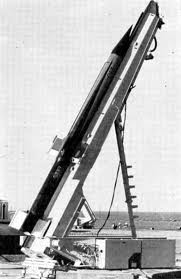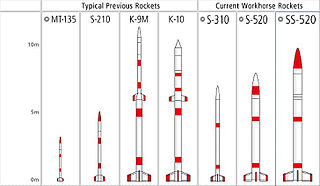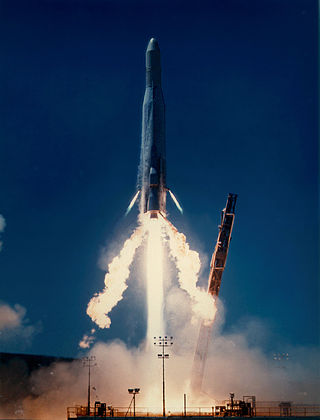
The Europa rocket was an early expendable launch system of the European Launcher Development Organisation (ELDO), which was the precursor to the European Space Agency (ESA). It was developed with the aim to delivering space access technology, and more specifically to facilitate the deployment of European-wide telecommunication and meteorological satellites into orbit.

Bérénice was the designation of a four-stage French atmospheric reentry test rocket, developed by O.N.E.R.A. .

Topaze is the designation of a French sounding rocket. The Topaze was developed by several French companies, notably Nord Aviation and Sud Aviation, and built by SEREB and was the first guidable French sounding rocket.

Monica is the designation of a small French sounding rocket. It was intended as a cheaper counterpart to the relatively expensive Veronique rockets.

The Éridan is a two-stage French sounding rocket, which results from the use of the Stromboli engine for the first and second stages.

Daniel (OPD-220-ADX) is the designation for a French experimental rocket, a precursor to the Israeli Jericho ballistic missile.

Centaure was a two-stage French sounding rocket consisting of a Venus first stage and a Belier second stage. It belongs to a family of solid-propellant rockets consisting of the Belier, Centaure, Dragon, Dauphin, and Eridan.

S-Series is a fleet of sounding rockets funded by the Japan Aerospace Exploration Agency (JAXA) that have been in service since the late 1960s. Manufactured by IHI Aerospace and operated by the Institute of Space and Astronautical Science (ISAS). The nomenclature of the S-Series rockets is the number of "S"s indicates the number of stages, and the following number details the diameter of the craft in millimeters. For example, the S-310 is a single stage rocket with a diameter of 310 mm.

The Kosmos rockets were a series of Soviet and subsequently Russian rockets, derived from the R-12 and R-14 missiles, the best known of which is the Kosmos-3M, which has made over 440 launches. The Kosmos family contained a number of rockets, both carrier rockets and sounding rockets, for orbital and sub-orbital spaceflight respectively. The first variant, the Kosmos-2I, first flew on 27 October 1961. Over 700 Kosmos rockets have been launched overall.

The Minotaur is a family of United States solid fuel launch vehicles derived from converted Minuteman and Peacekeeper intercontinental ballistic missiles (ICBM). They are built by Northrop Grumman via contract with the Air Force Space and Missile Systems Center's Space Development and Test Directorate (SMC/SD) as part of the Air Force's Rocket Systems Launch Program which converts retired Intercontinental Ballistic Missiles into space and test launch systems for U.S. government agencies.
Las Palmas is a rocket launch site in Argentina at 27.13°S 58.75°W used on November 12, 1966, for the launch of two Titus rockets for observing a solar eclipse.

This comparison of orbital launch systems lists the attributes of all individual rocket configurations designed to reach orbit. A first list contains rockets that are operational or in development as of 2023; a second list includes all upcoming rockets and a third list includes all retired rockets. For the simple list of all conventional launcher families, see: Comparison of orbital launchers families. For the list of predominantly solid-fueled orbital launch systems, see: Comparison of solid-fueled orbital launch systems.

The Atlas E/F was an American expendable launch system and sounding rocket built using parts of decommissioned SM-65 Atlas missiles. It was a member of the Atlas family of rockets.

A heavy-lift launch vehicle is an orbital launch vehicle capable of generating a large amount of lift to reach its intended orbit. Heavy-lift launch vehicles generally are capable of lifting payloads between 20,000 to 50,000 kg or between 20,000 to 100,000 kilograms into low Earth orbit (LEO). As of 2024, operational heavy-lift launch vehicles include the Long March 5, the Proton-M and Falcon Heavy.
A medium-lift launch vehicle (MLV) is a rocket launch vehicle that is capable of lifting between 2,000 to 20,000 kg by NASA classification or between 5,000 to 20,000 kilograms by Russian classification of payload into low Earth orbit (LEO). An MLV is between small-lift launch vehicles and heavy-lift launch vehicles.
CERESIle du Levant was a French suborbital rocket launch site, located at Ile du Levant, and active between 1956 and 1968. CERES played a pivotal role in testing a wide array of tactical missiles used in France, as well as conducting tests for sounding rockets on behalf of CNES and ESRO. Additionally, the center was involved in experiments with ONERA and SEREB experimental vehicles, solidifying its significance in the realm of missile research and testing.

The Antarès (OPd-56-39-22D) was a french multistage rocket designed by ONERA for reentry studies. In the late 1950s, the study of missile warhead reentry necessitated the development of a more robust rocket than the existing OR, VD and OPd series. The Antarès rocket, designated OPd-56-39-22D during its developmental phase, was designed to facilitate the study of kinetic heating on objects flying at speeds up to Mach 7.

Tibère was a French atmospheric reentry test rocket developed by O.N.E.R.A. . It evolved from its predecessor, Bèrènice, with development initiated in 1965 to support the ELECTRE reentry experiment program. Tibère, standing at a height of 14.5 m and weighing 4.5 tons, operated as a three-stage rocket.

The Titus sounding rocket was developed specifically by ONERA for observing the solar corona and conducting spectral analysis of the Sun's ultraviolet rays during the November 1966 solar eclipse in Argentina. The two-stage rocket, standing just over 11.5 meters tall and weighing 3045 kg without payload, could launch 400 kg to an altitude of 250 km.

LEX was a French experimental hybrid-propellant sounding rocket, developed by ONERA. It had the objective of testing a lithergol fueled rocket engine. It was the first rocket in history to use this technology, flying 8 times between 1964 and 1967.















